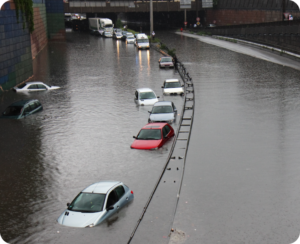We can’t warn you enough about flooding in the USA. Floods are predicted to be the environmental calamity that will most affect the global population shortly. One person in 5 is at risk of being hit by a flood at any given time.
These tragedies will happen in many parts of the world, in poor and rich countries, and poor and rich neighborhoods in big cities. However, lower-income people are at an even greater risk, as they live in less prepared homes and have fewer resources to start over.
You can’t be too careful; not only are floods hazardous, they can also destroy all the assets you’ve built. For this reason, we are going to give you 10 tips to prepare your home and minimize the damage that flooding can cause.
1. Discover your flood plan and flood risk
As we always say, information is key. FEMA mapped the country based on each region’s flood risks. While this mapping is not completely up to date, this is a tool that can help you understand your risks.
The Agency has created a letter classification that defines where the risk is low, where it is moderate and where it is high. Based on your area designation, you can find out what your region’s BFE is, which is how high the water is likely to rise in the event of a major flood.
However, it is important to be aware that many of the maps are out of date and some regions at risk are not registered yet. In a separate article, we recommend 6 questions to ask to better assess your neighborhood’s current situation.
2. If possible, transfer high risk items to above the BFE
Once you understand your home’s BFE, it’s time to protect your assets. When you discover that the BFE in your area is higher than any floor in your home, avoid leaving anything there that might be sensitive to water.
If possible, move electronics and other items to a higher floor or on top of a workbench, bookshelves, or bulk furniture. Sockets and switches can and should also be transferred, ideally they are at least 30 cm above the flood level.
3. Lift your home
An expensive but very effective solution is to elevate your home. There are varied techniques, from lifting using pillars, which are not affordable for many people. Another idea is to install water outlets on the lower floors, allowing water to flow freely in AND out, or you can seal the walls to prevent water from entering.
New buildings in communities participating in the National Federal Insurance Program are being constructed already meeting these specifications based on their flood risk.
3. Update your valves
A terrible effect of flooding is when the plumbing system becomes overloaded and backflows into your home. That is, even if your home is unharmed from external flooding, there can still be damage and a mess that you don’t want to deal with.
To prevent this, have a plumber install a backflow or gate valve in each drain pipe connected to your home. These valves are designed to keep water flowing in the right direction – out. Check with your local building department for permit requirements.
4. Keep up with maintenance
Having a house comes with many responsibilities, which includes keeping it in good working order to avoid further damage. After all, you want to enjoy where you live, don’t you? Leaks, broken door frames, and cracked windows all devalue the property, disrupts your life and leaves you more exposed to (sometimes) unnecessary risks.
To minimize the chances of water damage (in any climate), be sure to perform essential maintenance tasks in and around your property:
- Clean your gutters. Make sure they are securely fastened to your roof.
- Check your rain jets. Make sure they are positioned so that water runs away from your house and your neighbors’ houses.
- Repair any roof damage immediately. This prevents further damage and even helps keep your home insurance rates lower. If it’s an older building, consider a replacement when financial conditions permit.
- Repair sidewalks and driveways. Make sure these structures are not creating a water channel leading into your home.
- Check and seal openings and cracks in the foundation.
- Seal low doors and windows, especially those in the basement
- If you have old windows, consider installing new ones that come with more efficient sealing.
Even if you are not the owner of the house, you can make an agreement with your landlord so that his property is protected while you and your assets are protected.
5. Have a sump pump and test it regularly
A sump pump is a pump that removes water that accumulates in an area below ground level in your home, such as a basement. The faster you get rid of water, the less damage you can incur, making this a worthwhile investment.
Acting quickly can help prevent the growth of mold and mildew, consequences that can be very costly. So while the pump investment may initially seem high, it will likely pay off in emergency situations.
If you already have a sump pump, we recommend making sure that it is in good working order to ensure it’s there for you when you need it.
6. Turn off electricity when flooding is likely
Water and electricity is a very dangerous combination for your family. Before the flood even hits your door, eliminate the danger and turn off all the electricity in the house.
Water is a powerful conductor of electricity and the current generated can cause serious injury, in addition to causing damage.
If you’re caught by surprise by a flood before you have a chance to turn off the power, don’t wander into the wetlands. Call your energy supplier and ask them to cut the power as soon as possible!
7. Use the landscaping to your advantage
If you have a backyard or garden, you probably already know which areas are more likely to accumulate water. Using landscaping methods, you can slope your land so that water flows away from your home. Make sure the diversion doesn’t direct water into a neighbor’s house.
8. Contact the authorities
If you’ve noticed standing water on sidewalks or streets around your home, even after small storms, you and your neighbors may be at greater risk of flooding.
Contact your neighborhood representative or municipality authorities and request measures to improve drainage near you. This can actually help protect your community from several future losses.
9. Look for physical barriers against flooding
Consider installing flood barriers on windows and doors, and if possible, have sandbags handy. All concerns about the interior of the house can be minimized if you make it difficult for the water to pass through the entrance.
If you are in a high risk flood zone, try to create as many barriers as possible.
10. Review your insurance
Standard homeowners insurance policies do not cover flood damage, so it is important to be aware of the type of coverage you have. In some cases, you are able to include flood insurance in your original policy. Other times, it is necessary to purchase one separately.
Therefore, we strongly encourage you to review your coverage and ensure that your home is protected from all risks that are relevant to you.
If you already have Flood Insurance– the measures we listed can potentially get you a better rate, as some insurers reward risk reduction with lower prices!








